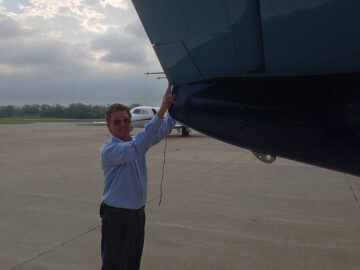By Mike Merek
First published in Flight Levels Online, Spring 2014 issue

As many of us know, this industry presents many technical challenges. Sometimes, when those challenges start to get in the way of the mission, we just have to stop and get back to the basics. For example, after a 35-year career in aircraft maintenance, I never thought that I would be typing on an iPad. However, within arm’s reach are my never-fail backups — pen and paper.
With the last 26 of those years standing next to Twin Commanders, one would think you would learn a thing or two. From the piston models, the 690 series, and now the 695, these aircraft have served us very well. With its high wing and broad stance the aircraft is easily identifiable by any aviation enthusiast, but only our community of Commander maintenance technicians knows that no two airframes are the same nowadays. Having 14 models on one FAA type certificate left a lot of room for many of us to get creative.
From my past trips to formal maintenance training classes taught by FlightSafety and, most recently, Eagle Creek, taking a good week to stop and get back to basics is the best way to improve my skills. Safety and economics dictate the need for formal training. Our loved ones, customers, and fellow aviators rely on our decisions. Having the training to make the right decision can make all the difference.
The FAA and some of our insurance underwriters require refresher training to maintain currency. That biennial flight review or eight hours for IAs should not be something to be dreaded.
With my recent attendance at the new factory-approved maintenance training class — or I should say, systems training — conducted at Eagle Creek, my understanding of the Twin Commander aircraft was reinforced. Although intended for maintenance technicians, pilots would benefit greatly from having a better understanding of their aircraft. At Eagle Creek, they have aircraft in many stages of repair so you can talk about something in the classroom and then go out in the hangar and see just what’s going on.
Unlike other training I’ve attended that was presented by instructors who were more like professional teachers than professional aviators, Mike Grabbe has a wealth of aviation experience. Having been in the factory when the Twin Commanders were still in production and actively involved with the aircraft since then, he is eager to share his knowledge.

As I grow older I feel even stronger that I need to improve my skills. Not just professionally, but personally. You know that mid-life crisis point when many of us say, “I think I’ll go back to school.” Formal Twin Commander maintenance training gives me that sense of accomplishment on the professional side. For personal fulfillment, I’m in the process of upgrading my Merchant Mariner credentials.
Fortunately, my employer encourages both professional and personal development. Training in government contracting is a continuous requirement. Online and formal classroom training is mandated by law. I’m looking forward to some human factors training back home in Tampa, and I’m planning on going to Phoenix this fall for Honeywell Dash 10 engine training. And I can always find time to watch a Garmin avionics CD. I highly recommend making the time and finding the resources to attend the formal training that is available to you.
I hope to see everyone in Savannah next spring at the Twin Commander University. Who knows, we may just learn something!
For more on Factory Authorized Maintenance Training, click here.
Mike Merek is a NOAA Equipment Specialist responsible for N45RF, a 695A Model 1000 Twin Commander.
